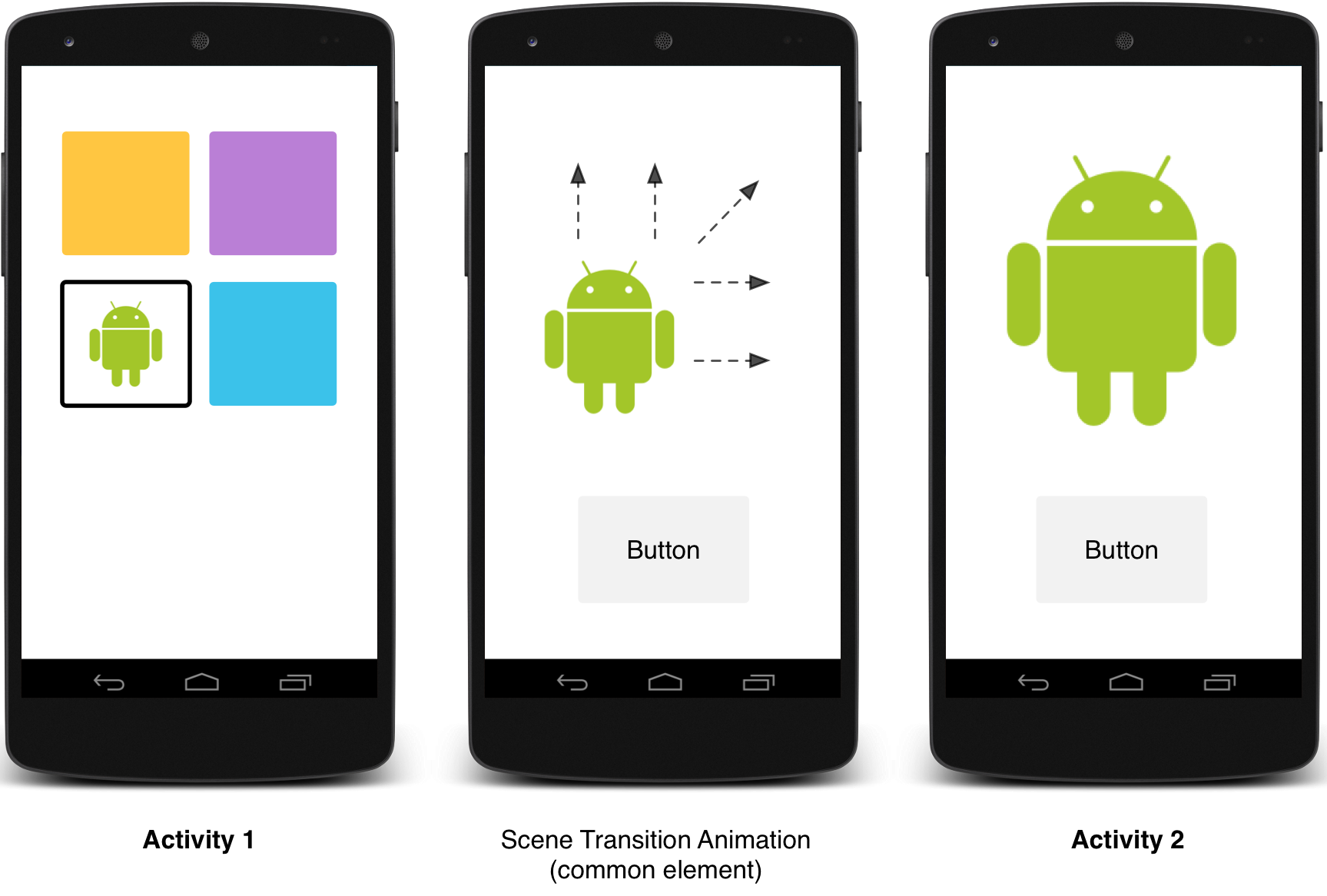Material Design 应用中的 Activity 转场通过运动和共同元素之间的变换,在不同状态之间提供视觉连接。您可以为进入和退出转场以及 Activity 之间共享元素的转场指定自定义动画。
图 1. 包含共享元素的转场。
- “进入”转场决定 Activity 中的视图如何进入场景。例如,在
explode进入转场中,视图从外部进入场景,然后飞入屏幕中心。 - “退出”转场决定 Activity 中的视图如何退出场景。例如,在
explode退出转场中,视图从中心向外退出场景。 - “共享元素”转场决定在两个 Activity 之间共享的视图如何在这两个 Activity 之间进行转场。例如,如果两个 Activity 在不同位置和大小上显示同一张图片,
changeImageTransform共享元素转场会在这两个 Activity 之间平滑地平移和缩放图片。
Android 支持以下进入和退出转场:
explode:将视图移入场景中心或从场景中心移出。slide:将视图从场景边缘之一移入或移出。fade:通过更改视图的不透明度将其添加到场景或从场景中移除。
任何扩展 Visibility 类的转场都支持作为进入或退出转场。如需了解详情,请参阅 Transition 类的 API 参考文档。
Android 还支持以下共享元素转场:
changeBounds:动画化目标视图布局边界的变化。changeClipBounds:动画化目标视图剪辑边界的变化。changeTransform:动画化目标视图缩放和旋转的变化。changeImageTransform:动画化目标图片大小和缩放的变化。
在应用中启用 Activity 转场后,进入和退出 Activity 之间会激活默认的交叉淡入淡出转场。

图 2. 包含一个共享元素的场景转场。
如需查看使用共享元素在 Activity 之间进行动画处理的示例代码,请参阅 ActivitySceneTransitionBasic。
检查系统版本
Activity 转场 API 可在 Android 5.0(API 21)及更高版本上使用。为了保持与早期 Android 版本的兼容性,在使用这些功能的 API 之前,请先在运行时检查系统 版本。
Kotlin
// Check if we're running on Android 5.0 or higher if (Build.VERSION.SDK_INT >= Build.VERSION_CODES.LOLLIPOP) { // Apply activity transition } else { // Swap without transition }
Java
// Check if we're running on Android 5.0 or higher if (Build.VERSION.SDK_INT >= Build.VERSION_CODES.LOLLIPOP) { // Apply activity transition } else { // Swap without transition }
指定自定义转场
首先,当您定义继承自 Material 主题的样式时,使用 android:windowActivityTransitions 属性启用窗口内容转场。您还可以在样式定义中指定进入、退出和共享元素转场。
<style name="BaseAppTheme" parent="android:Theme.Material"> <!-- enable window content transitions --> <item name="android:windowActivityTransitions">true</item> <!-- specify enter and exit transitions --> <item name="android:windowEnterTransition">@transition/explode</item> <item name="android:windowExitTransition">@transition/explode</item> <!-- specify shared element transitions --> <item name="android:windowSharedElementEnterTransition"> @transition/change_image_transform</item> <item name="android:windowSharedElementExitTransition"> @transition/change_image_transform</item> </style>
本示例中的 change_image_transform 转场定义如下:
<!-- res/transition/change_image_transform.xml --> <!-- (see also Shared Transitions below) --> <transitionSet xmlns:android="http://schemas.android.com/apk/res/android"> <changeImageTransform/> </transitionSet>
changeImageTransform 元素对应于 ChangeImageTransform 类。如需了解详情,请参阅 Transition 的 API 参考文档。
要在代码中启用窗口内容转场,请调用 Window.requestFeature() 函数。
Kotlin
// Inside your activity (if you did not enable transitions in your theme) with(window) { requestFeature(Window.FEATURE_ACTIVITY_TRANSITIONS) // Set an exit transition exitTransition = Explode() }
Java
// Inside your activity (if you did not enable transitions in your theme) getWindow().requestFeature(Window.FEATURE_ACTIVITY_TRANSITIONS); // Set an exit transition getWindow().setExitTransition(new Explode());
要在代码中指定转场,请使用 Transition 对象调用以下函数:
Window.setEnterTransition()Window.setExitTransition()Window.setSharedElementEnterTransition()Window.setSharedElementExitTransition()
setExitTransition() 和 setSharedElementExitTransition() 函数定义调用 Activity 的退出转场。setEnterTransition() 和 setSharedElementEnterTransition() 函数定义被调用 Activity 的进入转场。
为了获得完整的转场效果,您必须在调用 Activity 和被调用 Activity 上都启用窗口内容转场。否则,调用 Activity 会启动退出转场,但您随后会看到窗口转场(例如缩放或淡入淡出)。
要尽快开始进入转场,请在被调用 Activity 上使用 Window.setAllowEnterTransitionOverlap() 函数。这样可以实现更具戏剧性的进入转场。
使用转场启动 Activity
如果您启用转场并为某个 Activity 设置退出转场,则在您启动另一个 Activity 时,转场会如下所示地激活:
Kotlin
startActivity(intent, ActivityOptions.makeSceneTransitionAnimation(this).toBundle())
Java
startActivity(intent, ActivityOptions.makeSceneTransitionAnimation(this).toBundle());
如果您为第二个 Activity 设置进入转场,则在该 Activity 启动时,该转场也会激活。如需在启动另一个 Activity 时停用转场,请提供 null options bundle。
启动带共享元素的 Activity
要实现两个 Activity 之间带共享元素的屏幕转场动画,请执行以下操作:
- 在主题中启用窗口内容转场。
- 在样式中指定共享元素转场。
- 将转场定义为 XML 资源。
- 使用
android:transitionName属性为两个布局中的共享元素指定通用名称。 - 使用
ActivityOptions.makeSceneTransitionAnimation()函数。
Kotlin
// Get the element that receives the click event val imgContainerView = findViewById<View>(R.id.img_container) // Get the common element for the transition in this activity val androidRobotView = findViewById<View>(R.id.image_small) // Define a click listener imgContainerView.setOnClickListener( { val intent = Intent(this, Activity2::class.java) // Create the transition animation - the images in the layouts // of both activities are defined with android:transitionName="robot" val options = ActivityOptions .makeSceneTransitionAnimation(this, androidRobotView, "robot") // Start the new activity startActivity(intent, options.toBundle()) })
Java
// Get the element that receives the click event final View imgContainerView = findViewById(R.id.img_container); // Get the common element for the transition in this activity final View androidRobotView = findViewById(R.id.image_small); // Define a click listener imgContainerView.setOnClickListener(new View.OnClickListener() { @Override public void onClick(View view) { Intent intent = new Intent(this, Activity2.class); // Create the transition animation - the images in the layouts // of both activities are defined with android:transitionName="robot" ActivityOptions options = ActivityOptions .makeSceneTransitionAnimation(this, androidRobotView, "robot"); // Start the new activity startActivity(intent, options.toBundle()); } });
对于在代码中生成的共享动态视图,请使用 View.setTransitionName() 函数在两个 Activity 中指定通用元素名称。
要在完成第二个 Activity 时反转场景转场动画,请调用 Activity.finishAfterTransition() 函数,而不是 Activity.finish()。
启动带多个共享元素的 Activity
要在包含多个共享元素的两个 Activity 之间制作场景转场动画,请在两个布局中使用 android:transitionName 属性(或在两个 Activity 中使用 View.setTransitionName() 函数)定义共享元素,然后创建 ActivityOptions 对象,如下所示:
Kotlin
// Rename the Pair class from the Android framework to avoid a name clash import android.util.Pair as UtilPair ... val options = ActivityOptions.makeSceneTransitionAnimation(this, UtilPair.create(view1, "agreedName1"), UtilPair.create(view2, "agreedName2"))
Java
ActivityOptions options = ActivityOptions.makeSceneTransitionAnimation(this, Pair.create(view1, "agreedName1"), Pair.create(view2, "agreedName2"));

